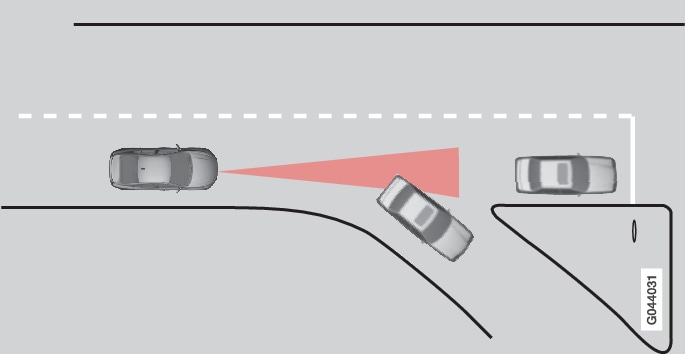In cars with automatic gearbox the adaptive cruise control is supplemented with the queue assistance function (also referred to as "Queue Assist").
- Extended speed range - also at lower than 30 km/h (20 mph) and at stationary
- Change of target
- Automatic braking ceases when stationary
Note that the lowest programmable speed for the adaptive cruise control is 30 km/h (20 mph) - even though the cruise control is capable of following another vehicle down to 0 km/h, a lower speed cannot be selected.
Learn more about how you manage the speed and different time intervals to the vehicle in front.
Extended speed range
Note
With an automatic gearbox, the adaptive cruise control can follow another vehicle within the range 0-200 km/h (0-125 mph).
Note
- Press the steering wheel button

...or...
- Depress the accelerator pedal.
| > | The cruise control will then resume following the vehicle in front. |
Note
The Queue Assist function can keep the car stationary for a maximum of 4 minutes - then the brakes release.
See more information under the heading "Termination of automatic braking at a standstill".
Change of target

When the adaptive cruise control is following another vehicle at speeds lower than 30 km/h (20 mph) and the target is changed from a moving vehicle to a stationary vehicle, the cruise control will brake for the stationary vehicle.
Warning
When the adaptive cruise control is following a vehicle in front at speeds in excess of 30 km/h (20 mph) and the target is changed from a vehicle in front to a stationary vehicle, the adaptive cruise control will ignore the stationary vehicle and instead select the stored speed.
- The driver must intervene him/herself and brake.
Automatic standby mode with change of target
- when the speed is below 5 km/h (5 mph) and the cruise control is uncertain whether the target object is a stationary vehicle or some other object, e.g. a speed bump.
- when the speed is below 5 km/h (5 mph) and the vehicle in front turns off so the cruise control no longer has a vehicle to follow.
Termination of automatic braking at a standstill
- the driver opens the door
- the driver takes off his seatbelt.
This means that the brakes are released and the car will start to roll - the driver must therefore intervene and brake the car himself in order to maintain its position.
Important
Queue Assist can keep the car stationary for a maximum of 4 minutes - then the brakes release.
The driver's attention is drawn to this over several stages, with increasing intensity:
- Acoustic alarm (pinging) and text message.
- A warning lamp in the windscreen also starts to flash.
- "Stabbing" braking occurs.
For more information on symbols, messages and their meaning, see the section Symbols and messages in the display.
- the driver puts his/her foot on the brake pedal
- the gear selector is moved to P, N or R position
- the driver sets the cruise control in standby mode
- the parking brake is applied.